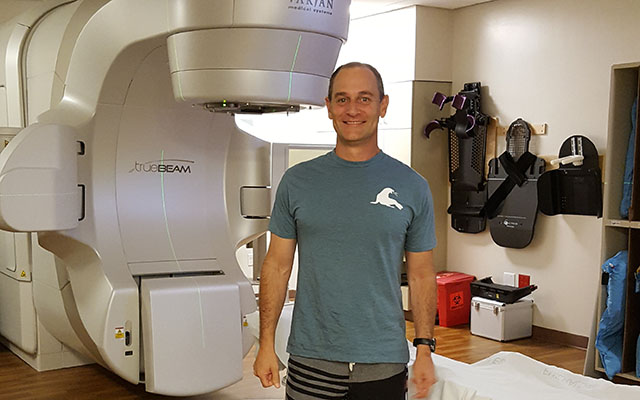
Mission: Search and Destroy Prostate Cancer
Advances in imaging, genomics and new therapies have changed how UC San Diego Health treats prostate cancer
Published Date
By:
- Yadira Galindo
Share This:
Article Content
During Brian McCloskey’s first-ever visit with a urologist, he was prescribed antibiotics for what was thought to be an infection of the prostate. When symptoms did not resolve, the urologist suggested the 51-year-old McCloskey undergo a biopsy.
“You’re such a low risk, I don’t expect to find anything,” McCloskey remembers the urologist saying in 2016, just days before receiving a prostate cancer diagnosis.
After skin cancer, prostate cancer is the most common cancer among males. One in nine men will receive a prostate cancer diagnosis in their lifetime. While the average age for diagnosis is 66, the number of younger men diagnosed with this disease is increasing.
“It’s always a possibility but you’re never prepared for it. I remember thinking ‘What does this mean? What do I need to know? How do I solve this problem?’” said McCloskey, a physically active father of three.
“You’re not concerned about cancer until it hits you and you need to become educated quickly. The first step is to understand the nature of the disease. To do that, start by speaking with an oncologist who understands the biology of the disease before undergoing any type of therapy or surgery.”
McCloskey’s research led him in December 2016 to Moores Cancer Center at UC San Diego Health, San Diego’s only National Cancer Institute-designated Comprehensive Cancer Center. After a consultation with prostate cancer experts Rana McKay, MD, medical oncologist, and Christopher Kane, MD, surgical oncologist, he underwent a radical prostatectomy — the surgical removal of the prostate gland and tissues surrounding it.
“Brian is a young man with a clinically significant prostate cancer. He chose to have surgery and it went safely. His recovery has gone well, but he had a recurrence after surgery because a small part of his cancer was aggressive and spread to lymph node tissue,” said Kane, CEO, UC San Diego Health Physician Group. “In general, recurrence means patients will undergo more treatment to gain control of the cancer. Many times, we can effectively treat prostate cancer so that no further treatment is needed or we can manage it like a chronic disease.”
In 2017, when McCloskey’s cancer first recurred, his health care team, composed of Kane, McKay and his radiation oncologist, John Einck, MD, as well as radiologists, pathologists and others, stabilized his disease for a year with a combination of radiation and hormone therapy.
As his levels of prostate specific antigen (PSA) — a protein produced by the prostate that increases when cancer is present — began to rise, McCloskey returned to hormone therapy in December 2018. He remained on the therapy for one year after which he was in remission and treatment was suspended.
“Today, we have more strategies to treat prostate cancer, including new drugs from hormone therapy to chemotherapy to immunotherapy and radiopharmaceuticals,” said McKay. “We have a better understanding of genetic mutations and what drives the disease. The landscape has definitely changed over the last 10 years which is helping us to strategize Brian’s care using genetic testing, precision medicine or clinical trials to find the best treatment for him.”
In March 2020, McCloskey’s PSA levels began to again rise rapidly.
That is when McCloskey began to undergo a series of progressively more advanced imaging tests. Starting with the standard CT and bone scans, the imaging revealed something in his thoracic spine and pelvis that was concerning. Rather than immediately perform surgery or a biopsy in a highly sensitive area, McCloskey and team opted for a thoracic magnetic resonance imaging (MRI) for detailed pictures of the spine. It determined the spinal mass was not cancerous, but a follow-up with a prostate specific membrane antigen (PSMA) PET-CT scan identified two concerning lymph nodes previously undetected on CT imaging.
“We were able to obtain a much better picture of my disease using advanced imaging technology that wasn’t available years ago,” said McCloskey. “We now have advanced images that can rule out as much as rule in the extent of disease which allows us to concentrate our efforts.”
Recently, McCloskey underwent a whole body MRI, which raised suspicion for metastasis to the peritoneum (the membrane lining the abdominal cavity).
“The abdomen is not a usual place for prostate cancer to spread to,” said McKay. “It was an unexpected finding. Advanced imaging has certainly been helpful in strategizing and trying to find where his cancer is and help guide us.”
In August 2020, Kane performed a robotic-assisted surgery using the da Vinci system to remove three recurrent tumors in McCloskey’s abdomen. McKay sat in during the operation reviewing the whole body MRI images with Kane to ensure targeting of suspicious areas.
“The scans were useful, not only to remove the cancer — we hope for the long-term — but it also allows Dr. McKay to measure molecular abnormalities in the tumors to help her treat against it,” said Kane.
McCloskey describes the operation as a “search and destroy mission” between his surgeon, whose expert reputation is renown, and his medical oncologist, who has assembled a team of specialists in every cancer field to find a personalized approach to continue or modify McCloskey treatment plan for stage IV prostate cancer.
These experts are among the members of UC San Diego Health’s multidisciplinary prostate cancer clinic — a clinic that focuses on improving prognosis and quality of life for men with aggressive or advanced prostate cancer while offering convenient and quick access to specialists during a single visit.
Combined with advanced therapy offerings, access to these specialists is among the reasons why both cancer and urology services at UC San Diego Health is ranked among the top in the nation in the 2020-2021 U.S. News & World Report.

Five weeks after surgery, McCloskey is already walking, jogging, surfing and beginning to resume his active lifestyle. Photo credit: Brian McCloskey
“We are combining everything we know through imaging and molecular data derived from tumor biopsies to find targeted therapies to help Brian,” said McKay. “A third of men with prostate cancer have an actionable alteration, we hope he has something we can target now or in the future as his cancer evolves over time.”
Because McCloskey underwent the minimally invasive surgery with the da Vinci system, Kane was able to perform a complicated operation through small laparoscopic openings. UC San Diego Health surgeons use robots as much as 10 times a day for a variety of diseases, including urologic, gynecologic and head and neck cancers as well as heart disease.
The small incisions mean patients recover more quickly. Five weeks after surgery, McCloskey is back to walking, jogging, surfing and beginning to resume his active lifestyle.
“It was Dr. Kane and his reputations that brought me to UC San Diego Health. But it’s the expertise and dedication of him, Dr. McKay and the entire staff that have provided me the personalized care I couldn’t get anywhere else. I know they have my back enabling me to thrive with this disease. They are the heroes in this fight against cancer,” said McCloskey.
“The public needs to know that advances in cancer treatment are accelerating like never before. From applied genomics to advanced imaging and new therapeutics, the promise of exponential medicine is real and UC San Diego Health is on the cutting edge. I am truly fortunate to have Moores Cancer Center with me on my journey every step of the way.”
Share This:
You May Also Like
Stay in the Know
Keep up with all the latest from UC San Diego. Subscribe to the newsletter today.



